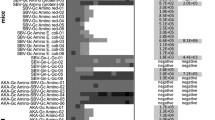A promising approach to the development of new means for preventing infection caused by tick-borne encephalitis virus can be DNA vaccines encoding polyepitope T-cell immunogens. A DNA vaccine pVAX-AG4-ub encoding an artificial polyepitope immunogen that includes cytotoxic and T-helper epitopes from the NS1, NS3, NS5, and E proteins of the tick-borne encephalitis virus has been obtained. The developed construct ensured the synthesis of the corresponding mRNAs in transfected eukaryotic cells. Immunization of mice with pVAX-AG4-ub induced the formation of a virus-specific T-cell response providing 50% protection from lethal infection with the virus.
Similar content being viewed by others
References
Erber W, Schmitt HJ, Janković TV. Epidemiology by country — an overview. The TBE Book. Dobler H, Erber W, eds. Singapore, 2020. P. 159-170.
Evolution of Tick-Borne Encephalitis (from the Discovery of the Pathogen to the Present Time). Pogodina VV, Ishmukhametova AA, eds. Tver, 2021. Russian.
Kollaritsch H, Paulke-Korinek M, Holzmann H, Hombach J, Bjorvatn B, Barrett A. Vaccines and vaccination against tick-borne encephalitis. Expert Rev. Vaccines. 2012;11(9):1103-1119. doi: https://doi.org/10.1586/erv.12.86
Xing Y, Schmitt HJ, Arguedas A, Yang J. Tick-borne encephalitis in China: A review of epidemiology and vaccines. Vaccine. 2017;35(9):1227-1237. doi: https://doi.org/10.1016/j.vaccine.2017.01.015
Kubinski M, Beicht J, Gerlach T, Volz A, Sutter G, Rimmelzwaan GF. Tick-borne encephalitis virus: a quest for better vaccines against a virus on the rise. Vaccines (Basel). 2020;8(3):451. doi: https://doi.org/10.3390/vaccines8030451
Antonets DV, Maksiutov AZ. TEpredict: software for T-cell epitope prediction. Mol. Biol. (Mosk). 2010;44(1):130-139.
Reynisson B, Alvarez B, Paul S, Peters B, Nielsen M. NetMHCpan-4.1 and NetMHCIIpan-4.0: improved predictions of MHC antigen presentation by concurrent motif deconvolution and integration of MS MHC eluted ligand data. Nucleic Acids Res. 2020;48(W1):W449-W454. doi: https://doi.org/10.1093/nar/gkaa379
Vita R, Mahajan S, Overton JA, Dhanda SK, Martini S, Cantrell JR, Wheeler DK, Sette A, Peters B. The Immune Epitope Database (IEDB): 2018 update. Nucleic Acids Res. 2019;47(D1):D339-D343. doi: https://doi.org/10.1093/nar/gky1006
Bazhan SI, Antonets DV, Karpenko LI, Oreshkova SF, Kaplina ON, Starostina EV, Dudko SG, Fedotova SA, Ilyichev AA. In silico designed Ebola virus t-cell multi-epitope DNA vaccine constructions are immunogenic in mice. Vaccines (Basel). 2019;7(2):34. doi: https://doi.org/10.3390/vaccines7020034
Bazhan SI, Antonets DV, Starostina EV, Ilyicheva TN, Kaplina ON, Marchenko VY, Volkova OY, Bakulina AY, Karpenko LI. In silico design of influenza a virus artificial epitope-based T-cell antigens and the evaluation of their immunogenicity in mice. J. Biomol. Struct. Dyn. 2022;40(7):3196-3212. doi: https://doi.org/10.1080/07391102.2020.1845978
Antonets DV, Bazhan SI. PolyCTLDesigner: a computational tool for constructing polyepitope T-cell antigens. BMC Res. Notes. 2013;6:407. doi: https://doi.org/10.1186/1756-0500-6-407
Grote A, Hiller K, Scheer M, Münch R, Nörtemann B, Hempel DC, Jahn D. JCat: a novel tool to adapt codon usage of a target gene to its potential expression host. Nucleic Acids Res. 2005;33(Web Server issue):W526-W531. doi: https://doi.org/10.1093/nar/gki376
Borgoyakova MB, Karpenko LI, Rudometov AP, Shanshin DV, Isaeva AA, Nesmeyanova VS, Volkova NV, Belenkaya SV, Murashkin DE, Shcherbakov DN, Volosnikova EA, Starostina EV, Orlova LA, Danilchenko NV, Zaikovskaya AV, Pyankov OV, Ilyichev AA. Immunogenic properties of the DNA construct encoding the receptor-binding domain of the SARS-CoV-2 spike protein. Mol. Biol. 2021;55(6):889-898. doi: https://doi.org/10.1134/S0026893321050046
Kisakov DN, Kisakova LA, Borgoyakova MB, Starostina EV, Taranov OS, Ivleva EK, Pyankov OV, Zaykovskaya AV, Shcherbakov DN, Rudometov AP, Rudometova NB, Volkova NV, Gureev VN, Ilyichev AA, Karpenko LI. Optimization of in vivo electroporation conditions and delivery of DNA vaccine encoding SARS-CoV-2 RBD using the determined protocol. Pharmaceutics. 2022;14(11):2259. doi: https://doi.org/10.3390/pharmaceutics14112259
Borgoyakova MB, Karpenko LI, Rudometov AP, Volosnikova EA, Merkuleva IA, Starostina EV, Zadorozhny AM, Isaeva AA, Nesmeyanova VS, Shanshin DV, Baranov KO, Volkova NV, Zaitsev BN, Orlova LA, Zaykovskaya AV, Pyankov OV, Danilenko ED, Bazhan SI, Shcherbakov DN, Taranin AV, Ilyichev AA. Self-assembled particles combining SARS-CoV-2 RBD protein and RBD DNA vaccine induce synergistic enhancement of the humoral response in mice. Int. J. Mol. Sci. 2022;23(4):2188. doi: https://doi.org/10.3390/ijms23042188.
Author information
Authors and Affiliations
Corresponding author
Additional information
Translated from Byulleten’ Eksperimental’noi Biologii i Meditsiny, Vol. 176, No. 7, pp. 85-89, July, 2023
Rights and permissions
Springer Nature or its licensor (e.g. a society or other partner) holds exclusive rights to this article under a publishing agreement with the author(s) or other rightsholder(s); author self-archiving of the accepted manuscript version of this article is solely governed by the terms of such publishing agreement and applicable law.
About this article
Cite this article
Kisakov, D.N., Antonets, D.V., Shaburova, E.V. et al. DNA Vaccine Encoding the Artificial T-Cell Polyepitope Immunogen of Tick-Borne Encephalitis Virus. Bull Exp Biol Med 176, 72–76 (2023). https://doi.org/10.1007/s10517-023-05970-4
Received:
Published:
Issue Date:
DOI: https://doi.org/10.1007/s10517-023-05970-4




